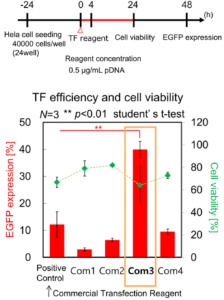Advantages
- High-efficiency transfection of long-chain plasmid DNA of 10 kbps or more, which was difficult with conventional reagents.
- No cytotoxicity.
- Can be easily prepared and can be made into a reagent kit.
Background and Technology
Conventionally, lipid-mediated transfection (lipofection) reagents are most commonly used to introduce plasmid DNA into animal cells and express target proteins. On the other hand, with conventional reagents, the transfection efficiency decreased as the length of the introduced DNA increased, and the transfection efficiency for long-chain DNA of 10 kbps or more was not sufficient.
The present invention efficiently introduces into cells by compacting long-chain plasmid DNAs, and then releases them into cells to express proteins with high efficiency.
The figure compares the transfection efficiency of EGFP (15 kbps) between the commercially available reagent and our technology (Com3)
 |
Reference and Patent
- Unpublished
- Patent pending
Principal Investigator
Masatoshi MAEKI (Hokkaido University Graduate School of Engineering)
Current Stage and Next Step
- We developed a highly efficient transfection method that compacts long-chain plasmid DNA.
- Elucidated the effect of compression conditions on transfection efficiency.
- Looking for partner companies to develop and commercialize long-chain plasmid DNA transfection reagent products using this technology.
- It is possible to conclude a CDA/MTA, disclose technical details, and conduct an evaluation/feasibility study.
Project No. BK-04716


